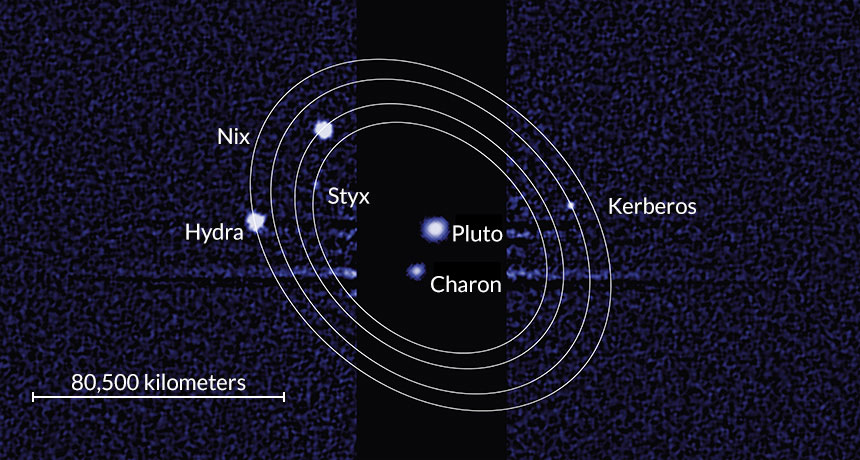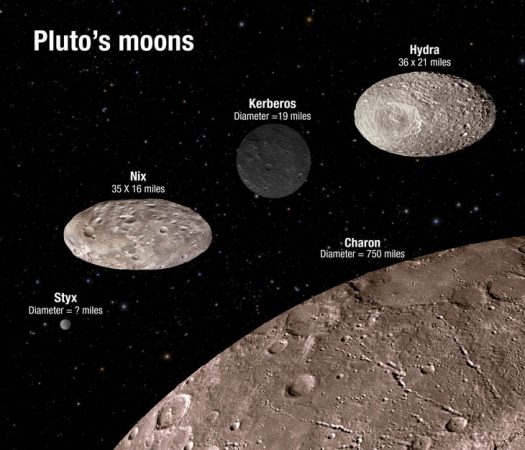Cosmic collision may have given birth to Pluto’s moons
The darker color of Kerberos, one of the satellites, could be a clue to its origin

Pluto’s outer moons are seen here in an image from the Hubble Space Telescope image. The moons are tightly packed in nearly synced orbits. This suggests that they formed in the wake of a collision.
NASA, ESA, M. SHOWALTER/SETI INSTITUTE
Share this:
- Share via email (Opens in new window) Email
- Click to share on Facebook (Opens in new window) Facebook
- Click to share on X (Opens in new window) X
- Click to share on Pinterest (Opens in new window) Pinterest
- Click to share on Reddit (Opens in new window) Reddit
- Share to Google Classroom (Opens in new window) Google Classroom
- Click to print (Opens in new window) Print
At the far edge of the solar system, five satellites orbit the dwarf planet Pluto. The moons are so small that a powerful telescope is needed to see them from Earth. Now, seven years of images from the Hubble Space Telescope have revealed that the four smallest moons — Styx, Nix, Kerberos and Hydra — are packed together about as tightly as possible. Their four orbits, plus that of the largest moon, Charon, are nearly synced. That suggests these moons formed long ago from debris left behind after something big slammed into Pluto.
The properties of the moons today hint at how they formed, says Mark Showalter. He is a planetary scientist at the SETI Institute in Mountain View, Calif. Showalter worked with planetary scientist Douglas Hamilton of the University of Maryland at College Park. They published their findings in the June 4 issue of Nature.
The moons of Pluto keep coming back to nearly the same configuration time and time again, the researchers found. Charon completes three orbits, for instance, in roughly the same time Styx loops around once. Since it’s unlikely that all five moons became synced by chance, they likely have a common origin, Showalter and Hamilton now conclude.
Their tight spacing also indicates that there are probably no other moons or rings lurking among the four smallest moons. One of those satellites would eventually have snatched up any debris.
Kerberos is the oddball in this group of moons. It appears to have a surface that is much darker than its siblings. “The small satellites should have very similar surfaces,” says Marc Buie. He is a planetary scientist at the Southwest Research Institute in Boulder, Colo. He was not involved in the research. “Kerberos appears to be off-the-charts different,” he says.
This moon might be part of the unknown object that struck Pluto, says Showalter. The other moons could be remnants of the dwarf planet itself.
The four small moons tumble unpredictably along their orbits as they are nudged by the gravity of the larger Charon and Pluto. “On Nix, you wouldn’t know if the sun was coming up tomorrow,” says Showalter. If it rose at all, the sun might rise in the east one day and come up in the north the next. “You’d be living on a random world with no day-night cycle,” he points out.
A spacecraft called New Horizons will visit Pluto and its posse on July 14. This probe left Earth in 2006 and has been whizzing out toward the edge of the solar system ever since. New Horizons will tear past the distant group at nearly 50,000 kilometers per hour (31,000 miles per hour), and should get the best view yet of the moons, Buie says.
“Pluto has not let us down yet,” Showalter says. “It’s always been a bit more interesting than expected.”

Power Words
(for more about Power Words, click here)
dwarf planet One of the solar system’s small celestial objects. Like a true planet, it orbits the sun. However, dwarf planets are too small to qualify as true planets. Prime examples of these objects: Pluto and Ceres.
moon The natural satellite of any planet.
orbit The curved path of a celestial object or spacecraft around a star, planet or moon. One complete circuit around a celestial body.
Pluto A dwarf planet that is located in the Kuiper Belt, just beyond Neptune. Pluto is the tenth largest object orbiting the sun.
satellite A moon orbiting a planet or a vehicle or other manufactured object that orbits some celestial body in space.
telescope Usually a light-collecting instrument that makes distant objects appear nearer through the use of lenses or a combination of curved mirrors and lenses. Some, however, collect radio emissions (energy from a different portion of the electromagnetic spectrum) through a network of antennas.







